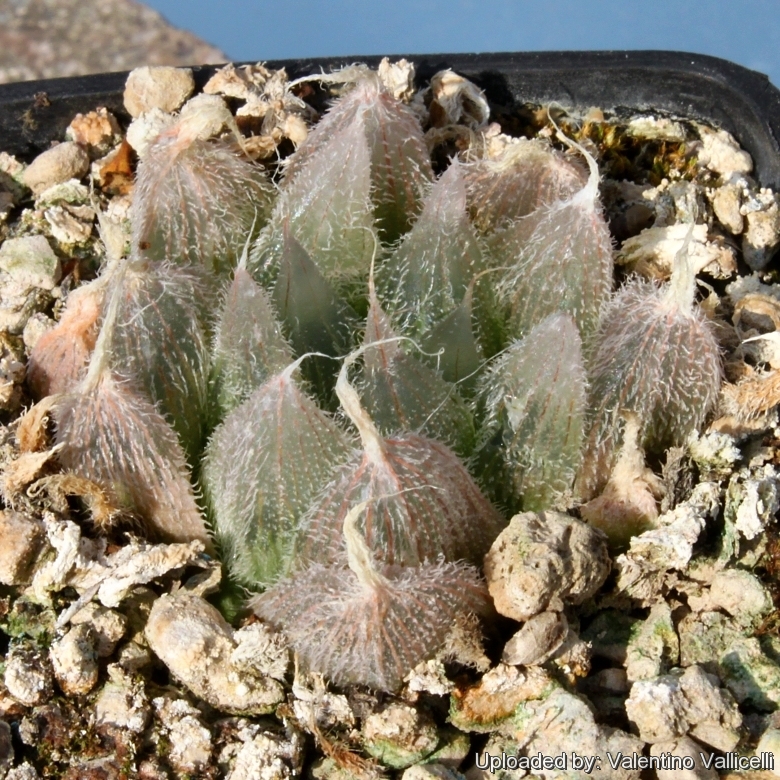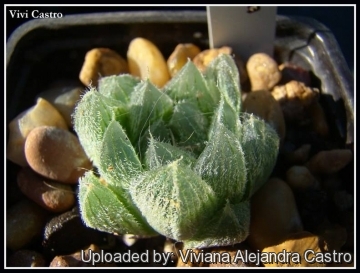




Your support is critical to our success.
Accepted Scientific Name: Haworthia cooperi var. venusta (C.L.Scott) M.B.Bayer
Haworthia Revisited 56 (1999)

North-east of Alexandria near the Kasouga River.
Origin and Habitat: Endemic of a very small area only around 20 x 20 m near the Kasouga River in the proximity of the habitat of Hawothia coarctata and Haworthia cymbiformisSN|975]]SN|975]].
Synonyms:
- Haworthia cooperi var. venusta (C.L.Scott) M.B.Bayer
- Haworthia venusta C.L.Scott
Haworthia cooperi Baker
Refug. Bot. (Saunders) 4: t. 233 (1870)
Synonymy: 5
- Haworthia cooperi Baker
- Catevala cooperi (Baker) Kuntze
- Haworthia cooperi f. variegata hort.
- Haworthia vittata Baker
- Catevala vittata (Baker) Kuntze
Haworthia cooperi var. dielsiana (Poelln.) M.B.Bayer
Haworthia Revisited 51 (1999)
Synonymy: 5
- Haworthia cooperi var. dielsiana (Poelln.) M.B.Bayer
- Haworthia dielsiana Poelln.
- Haworthia obtusa var. dielsiana (Poelln.) Uitewaal
- Haworthia pilifera var. dielsiana (Poelln.) Poelln.
- Haworthia joeyae C.L.Scott
Haworthia cooperi var. doldii M.B.Bayer
Haworthiad 16: 65 (2002)
Synonymy: 2
- Haworthia cooperi var. doldii M.B.Bayer
- Haworthia doldii (M.B.Bayer) M.Hayashi
Haworthia cooperi var. gordoniana (Poelln.) M.B.Bayer
Haworthia Revisited 52 (1999)
Synonymy: 4
- Haworthia cooperi var. gordoniana (Poelln.) M.B.Bayer
- Haworthia gordoniana Poelln.
- Haworthia obtusa var. gordoniana (Poelln.) Uitewaal
- Haworthia pilifera var. gordoniana (Poelln.) Poelln.
Haworthia cooperi var. leightonii (G.G.Sm.) M.B.Bayer
Haworthia Handb. 128 (1976)
Synonymy: 2
- Haworthia cooperi var. leightonii (G.G.Sm.) M.B.Bayer
- Haworthia leightonii G.G.Sm.
Haworthia cooperi var. pilifera (Baker) M.B.Bayer
Haworthia Revisited 54 (1999)
Synonymy: 7
- Haworthia cooperi var. pilifera (Baker) M.B.Bayer
- Catevala pilifera (Baker) Kuntze
- Haworthia cooperi f. pilifera (Baker) Pilbeam
- Haworthia obtusa var. pilifera (Baker) Uitewaal
- Haworthia pilifera Baker
- Haworthia pilifera f. acuminata Poelln.
- Haworthia obtusa f. acuminata (Poelln.) Uitewaal
Haworthia cooperi var. truncata (H.Jacobsen) M.B.Bayer
Haworthia Revisited 55 (1999)
Synonymy: 3
- Haworthia cooperi var. truncata (H.Jacobsen) M.B.Bayer
- Haworthia cooperi var. obtusa hort.
- Haworthia obtusa f. truncata H.Jacobsen
Haworthia cooperi var. venusta (C.L.Scott) M.B.Bayer
Haworthia Revisited 56 (1999)
Synonymy: 2
- Haworthia cooperi var. venusta (C.L.Scott) M.B.Bayer
- Haworthia venusta C.L.Scott
Description: Haworthia cooperiSN|16729]]SN|14982]] var. venusta is the beauty among others “cooperi”” with leaves covered with white hairs. It is a slow growing species that may form clumps.
Rosettes: Stemless that in nature have only few leaves and remain quite small. In cultivation they can grow much bigger (which is true with most succulent plants, of course). This species tends to remain solitary though may cluster slowly in time in cultivation.
Leaves: Fat, windowed, covered in silvery-white fuzz with soft teeth and tips. (similar to Haworthia pubescensSN|14982]]SN|16729]]).
Subspecies, varieties, forms and cultivars of plants belonging to the Haworthia cooperi group
 Haworthia cooperi Baker: has densely clustered rosettes usually withdrawn in the soil, the transparent tips allowing light into the factory below. It is a variable. Distribution: Eastern Cape.
Haworthia cooperi Baker: has densely clustered rosettes usually withdrawn in the soil, the transparent tips allowing light into the factory below. It is a variable. Distribution: Eastern Cape.- Haworthia cooperi var. dielsiana (Poelln.) M.B.Bayer
- Haworthia cooperi var. doldii M.B.Bayer
- Haworthia cooperi var. gordoniana (Poelln.) M.B.Bayer
- Haworthia cooperi var. leightonii (G.G.Sm.) M.B.Bayer: has reddish longitudinal lines towards the end of the leaf. This variety often appears in nurserymen's lists as leightoniae.
- Haworthia cooperi var. pilifera (Baker) M.B.Bayer
 Haworthia cooperi var. truncata (H.Jacobsen) M.B.Bayer: has soft leaves, somewhat spherical with blue-green translucent-patterns. Distribution: Eastern Cape Province, north of East London
Haworthia cooperi var. truncata (H.Jacobsen) M.B.Bayer: has soft leaves, somewhat spherical with blue-green translucent-patterns. Distribution: Eastern Cape Province, north of East London Haworthia cooperi f. variegata hort.: variegated form.
Haworthia cooperi f. variegata hort.: variegated form. Haworthia cooperi var. venusta (C.L.Scott) M.B.Bayer: has fat, windowed leaves covered in silvery-white fuzz with soft teeth and tips. Distribution: Endemic of a small area (20 x 20 m) near the Kasouga River.
Haworthia cooperi var. venusta (C.L.Scott) M.B.Bayer: has fat, windowed leaves covered in silvery-white fuzz with soft teeth and tips. Distribution: Endemic of a small area (20 x 20 m) near the Kasouga River.
Notes: This plant is a choice example of the window-leaf ( fenestrate leaf) adaptation found in many Haworthias, Mesembreanthemums and Peperomias, the translucent 'glassy' windowed apices allow light into the internal plant body rich in chlorophyll-bearing layers of cells, thereby providing a much larger assimilation area.
The windows greatly increase the photosynthesizing area by allowing light into the centres of leaves and at the same time avoiding water loss.
Bibliography: Major references and further lectures
1) Gordon D. Rowley “The illustrated encyclopedia of succulents” Crown Publishers, 01/Aug/1978
2) Doreen Court “Succulent Flora of Southern Africa” CRC Press, 01/Jun/2000
3) Urs Eggli “Illustrated Handbook of Succulent Plants: Monocotyledons” Springer, 2001
4) Charles L. Scott “The genus Haworthia (Liliaceae): a taxonomic revision” Aloe Books, 1985
5) Stuart Max Walters “The European Garden Flora: Pteridophyta, Gymbospermae, Angiospermae-Monocotyledons” Cambridge University Press, 1984
6) M. B. Bayer “The new Haworthia handbook” National Botanic Gardens of South Africa, 1982
7) John Pilbeam “Haworthia and Astroloba: A Collector's Guide” B. T. Batsford Limited, 1983
8) Bruce Bayer “Haworthia revisited: a revision of the genus” Umdaus Press, 1999
9) Ernst Van Jaarsveld, Ben-Erik Van Wyk, Gideon Smith “Succulents of South Africa: A Guide to the Regional Diversity” Tafelberg Publishers, Limited, 01/Jul/2000
10) ames D. Mauseth “Botany: An Introduction to Plant Biology” Jones & Bartlett Publishers, 2014
11) Charles L. Scott “The Genus Haworthia (Liliaceae): A Taxonomic Revision” Aloe Books, 1985
12) Noel Urton “Plants of the Swartkops valley bushveld” Zwartkops Trust, 1993
13) Manning, J.C., Boatwright, J.S., Daru, B.H., Maurin, O. and Van der Bank, M. “A molecular phylogeny and generic classification of Asphodelaceae subfamily Alooideae: A final resolution of the prickly issue of polyphyly in the Alooids?” Systematic Botany 39(1):55-74. 2014
14) von Staden, L., Klopper, R. & Manning, J.C. 2014. Haworthia cooperi Baker. “National Assessment: Red List of South African Plants” version 2014.1. Accessed on 2014/06/10
15) J. G. Baker “Flora Capensis” page 253 1897
16) Bayer, M.B and van Jaarsveld, E. 2001. “Haworthia. in Illustrated Handbook of Succulent Plants: Monocotyledons.” Springer, Berlin.
17) Bayer, M.B. 1999. “Haworthia Revisited: A revision of the genus.” Umdaus Press, Hatfield.
18) Bayer, M.B. and Manning, J.C. “The Haworthia nomenclator: A list of accepted species with some guidelines for infraspecific names.” Haworthia Update 7(4):30-40.2012

Haworthia venusta (Haworthia cooperi var. venusta) Photo by: Viviana Alejandra Castro
The gallery now contains thousands of pictures, however it is possible to do even more. We are, of course, seeking photos of species not yet shown in the gallery but not only that, we are also looking for better pictures than those already present. Read More...
Cultivation and Propagation: There's no difference in cultivation from usual plants of this type. Though it grows more slowly.
Exposure: Needs light shade to shade.
Watering needs: Regular water (They enjoy a little water during winter period too) but do not overwater as they will most likely wind up with root rot, and do not water again until dry!
Hardyness: Hardy to to -5°C (or less if dry).
| Your Actions | |
|---|---|
| Back to Haworthia index | |
| Back to Aloaceae index | |
 |
Back to Succulents Encyclopedia index |
Privacy stantement - Terms and conditions - How to cite - About us - Feedback - Donate



